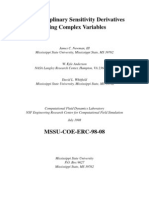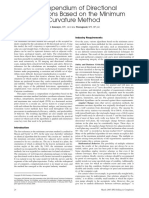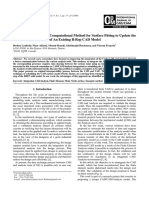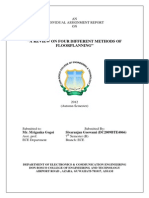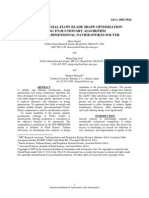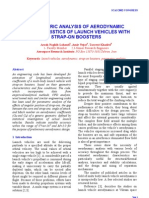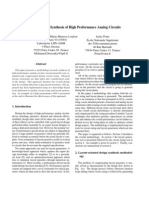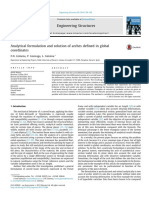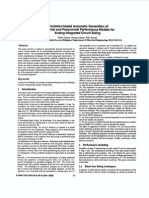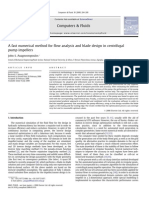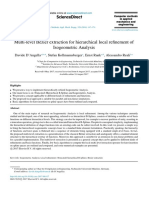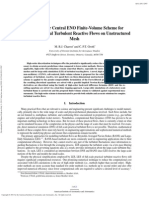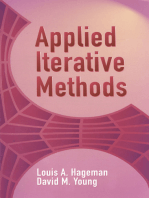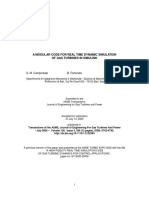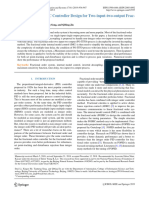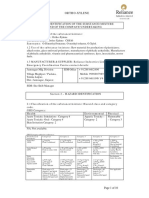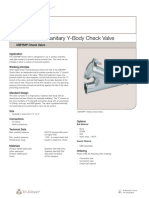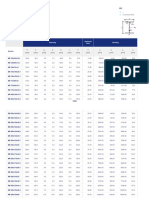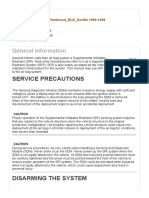Aiaa-5642 2002
Aiaa-5642 2002
Uploaded by
alkadyasCopyright:
Available Formats
Aiaa-5642 2002
Aiaa-5642 2002
Uploaded by
alkadyasOriginal Title
Copyright
Available Formats
Share this document
Did you find this document useful?
Is this content inappropriate?
Copyright:
Available Formats
Aiaa-5642 2002
Aiaa-5642 2002
Uploaded by
alkadyasCopyright:
Available Formats
Genetic Algorithm (real-coded ARGA) is used for design optimization.
To represent flow fields accurately and produce reliable designs, threedimensional Navier-Stokes computation is used for aerodynamic analysis. To reduce turn-around time, the computation is parallelized on the SGI ORIGIN2000 cluster at the Institute of Fluid Science, Tohoku University of Japan, by distributing flow analyses of design candidates to 64 processing elements. The present method is applied to aerodynamic redesign of NASA rotor67 20. THREE-DIMENSIONAL NAVIER-STOKES SOLVER FOR CASCADE FLOW Flow field inside high-speed axial-flow turbomachinery is highly three-dimensional and involves significant viscous effects, such as boundary-layer separations and shock wave/boundary layer interactions. Therefore three-dimensional Navier-Stokes computations are essential for blade shape optimization because further improvement in the aerodynamic performance requires detailed knowledge of the flow structure such as secondary flows and tip clearance flow. In this study, the three-dimensional NavierStokes code TRAF3D21,22 is used for aerodynamic analysis of blade designs. Capability of the present code has been validated by comparing the computed results to some experiments such as the Goldman annular vane with and without end wall contouring, the low speed Langston linear cascade21 as well as the NASA rotor67 22. The present code solves the three-dimensional full Reynolds-averaged Navier-Stokes equations. The present code uses a central-differencing scheme including artificial dissipation terms introduced by Jameson, Schmidt, and Turkel23 to maintain stability and to prevent oscillations near shocks or stagnation points. In order to minimize the amount of artificial diffusion inside the shear layer, the eigenvalues scaling of Martinelli24 and Swanson and Turkel25 are used. The two-layer eddy-viscosity model of Baldwin and Lomax is used for the turbulence closure. The system of the differential equations is advanced in time using an explicit four-stage Runge-Kutta scheme. In order to accelerate convergence of calculations, local time-stepping, implicit residual smoothing26, and the Full Approximation Storage (FAS) multigrid technique27 are used. At the subsonic axial inlet, the flow angles, total pressure and total enthalpy are specified according to the theory of characteristics while the outgoing Riemann invariant is taken from the interior. At the subsonic axial outlet, the average value of the static pressure at the hub is prescribed and the density and components of velocity are extrapolated together
with the circumferential distribution of pressure. The radial equilibrium equation is used to determine the spanwise distribution of the static pressure. On sidewalls, the momentum equation, the no-slip condition, and the temperature condition are used to compute pressure and density. For the calculations presented in this paper, all the walls have been assumed to be adiabatic. The periodicity from blade passage to blade passage is imposed by setting periodic phantom cell values. At the wake, where the grid is not periodic, the phantom cells overlap the real ones. Linear interpolations are then used to compute the value of the dependent variables in phantom cell. The three-dimensional grids are obtained by stacking two-dimensional grids generated on the blade-to-blade surface. These two-dimensional grids are of C-type and are elliptically generated, with controlled grid spacing and orientation at the wall. The problem of grid skewness due to high stagger or large camber is addressed by allowing the grid to be non-periodic on the wake28. By adding lines near the wall, viscous grids are obtained from the inviscid grids. The wall normal spacing scaled with the axial chord is 10-4. In the spanwise direction a standard Htype structure has been adopted. Near the hub and tip walls geometric stretching is used for a specified number of grid points, after which the spanwise spacing remains constant. The number of the grid points is 201 chordwise x 53 tangential x 57 spanwise. Among the 201 chordwise grid points, 149 grid points are distributed along the blade shape. The computational grid for NASA rotor67 is shown in Fig. 1. BLADE SHAPE PARAMETERIZATION Here a rotor blade shape is represented by four blade profiles, respectively at 0%, 31%, 62%, and 100% spanwise stations (all spanwise locations discussed here are measured from the hub) and linearly interpolated. Each of these sectional profiles can be uniquely defined by using a mean camber line and a thickness distribution and they are parameterized by the third-order B-Spline curves. Parameterization using B-Spline curves is one of the most popular approaches for airfoil designs. When B-Spline curves are used for shape parameterization, positions of control points of the BSpline curves are often considered as the design parameters. Here, five control points are used for the mean camber line as illustrated in Fig 2. For the thickness distribution, two control points are added at the leading edge and the trailing edge so that these points represent leading edge and trailing edge radii, respectively. Chordwise locations of the control points at leading edge and trailing edge are frozen to
3 American Institute of Aeronautics and Astronautics
zero and one, respectively. As a result, 14 design parameters are required to represent a sectional shape. Each blade shape is then represented with 56 design parameters. EVOLUTIONARY ALGORITHM EAs mimic mechanism of natural evolution, where a biological population evolves over generations to adapt to an environment by selection according to fitness, recombination and mutation of genes (Fig. 3). In EAs, a design candidate, objective function values, and design variables usually correspond to an individual, fitness, and genes, respectively. Starting with an initial population of design candidates that is often generated by random sampling from the design space, EAs select good design candidates in terms of fitness, which is assigned on the bias of their objective function values. Typically, fitness of a design candidate is its objective function value itself for a single objective problem. Recombination is applied, where new population is generated by exchanging features of the selected designs with the intent of improving the fitness of the next generation. Then, mutation is applied to design parameters of the new population to maintain diversity in the population. One of the key features of EAs is that it searches from multiple points in the design space in contrast to the traditional methods that usually move from a single design point. In addition, EAs use objective function values alone to determine a search direction and do not require gradients of the objective function while the traditional methods use local gradient information of an objective function. These features also lead to advantages such as, 1) Robustness: Deterministic methods, such as the gradient-based methods, typically start with a single design point and use the local gradient information to determine a search direction. As a result, they generally lead to a local, not necessarily a global optimum near the starting point. In contrast to them, EAs determine their search direction globally and probabilistically but efficiently using their unique operators socalled recombination and mutation that give EAs capability of finding global optimums. Compared with other probabilistic methods such as the simulated annealing method29 that is similar to the gradient-based methods but tries a random step according to the so-called Boltzmann probability distribution, EAs are more robust because they maintain a population of design candidates and they don t use function gradients that direct the search toward a local optimum. In addition, EAs have a capability to handle any design problems that may involve
non-differentiable objective function and/or a mix of continuous, discrete, and integer design parameters. 2) Suitability to parallel computing: Because EAs are population-based search algorithms, all design candidates in each generation can be evaluated in parallel by using the simple masterslave concept. Parallel efficiency is extremely high, if objective function evaluations consume most of the computational time. Aerodynamic design optimization is a typical case. 3) Simplicity in coupling evaluation codes: Because EAs use only objective function values of design candidates, EAs do not need substantial modification or sophisticated interface to evaluation codes. If an all-out re-coding were required to every optimization problem, extensive validation of the new code would be necessary every time. EAs can save such troubles. 4) Straightforward application to multiobjective optimization problems: Because EAs maintain multiple designs, EAs can find compromised optimum designs, so-called Pareto-optimal solutions, by introducing Pareto-optimal concept. In the present study, the real-coded AdaptiveRange Genetic Algorithm30 (real-coded ARGA) is used. The real-coded ARGA is an EA that can solve large-scale design optimization problems very efficiently by promoting the population toward promising design regions during the optimization process. To represent design parameters of design candidates, the floating-point representation31 is used where an individual is characterized by a vector of real numbers. It is natural to use the floating-point representation for real parameter optimization problems instead of binary representation, because it is conceptually closest to the real design space, and moreover, the string length is reduced to the number of design variables. The parental selection consists of the stochastic universal sampling32 and the ranking method31. To handle design constraints, the constrained domination approach33 is used. Blended crossover34 (BLX-0.5) is used for recombination. Mutation takes place at a probability of 10% and then adds a random disturbance to the corresponding gene. The present EA adopts the elitist strategy35 where the best and the second best individuals in each generation are transferred into the next generation without any recombination or mutation. Population size is set to 64. The main concern related to the use of a threedimensional Navier-Stokes solver for aerodynamic shape design is the required computational effort.
4 American Institute of Aeronautics and Astronautics
Algorithms, Morgan Kaufmann Publishers, Inc., San Mateo, California, 1987, pp 14-21. 33) Deb, K., Pratap, A. and Moitra, S., Mechanical Component Design for Multiple Objectives Using Elitist Non-Dominated Sorting GA, Lecture Notes in Computer Science 1917 Parallel Problem Solving from Nature PPSN VI, edited by Schoenauer, M., Deb, K., Rudolph, G., Yao, X., Lutton, E., Merelo, J. J., and Schwefel, H.-P., Springer, Berlin, Germany, 2000, pp.859-868. 34) Eshelman, L. J. and Schaffer, J. D., Real-Coded Genetic Algorithms and Interval Schemata, Foundations of Genetic Algorithms.2, Morgan Kaufmann Publishers, Inc., San Mateo, California, 1993, pp 187-202. 35) De Jong, K. A., An Analysis of the Behavior of a Class of Genetic Adaptive Systems, Doctoral Dissertation, University of Michigan, Ann Arbor, 1975.
camber line
0.2 0.15
z/c
0.1
0.25
blade profile
control points B-Spline curves 0.2 0.4 0.6 0.8 1
0.15 0.2
0.05 0 0
x/c
z/c
0.06 0.05 0.04
thickness distribution
0.1 0.05 0 0 0.2 0.4 0.6 0.8 1
z/c
0.03 0.02 0.01 0 0 0.2 control points B-Spline curves 0.4
x/c
x/c
0.6
0.8
Figure 2. B-Spline curves for mean camber line and thickness distribution and the resultant blade profile.
initial population evaluation of designs Next generation selection according to fitness recombination of selected designs
mutation applied to new designs Figure 3. Flowchart of typical evolutionary algorithms.
0.01
entropy production
0.0095 0.009 0.0085 0.008 0.0075 0.007 0 20 40
rotor67 optimized designs
Figure 1. Computational grid over NASA rotor67.
60
80
100
generation
Figure 4. Optimization history in terms of entropy production.
8 American Institute of Aeronautics and Astronautics
You might also like
- The Wind-Tunnel Calibration Techniques Used in Modern Day Aviation To Maintain Test AccuracyDocument9 pagesThe Wind-Tunnel Calibration Techniques Used in Modern Day Aviation To Maintain Test AccuracyMj Santos100% (1)
- GB 50011-2010 (2016) - EN - Code For Seismic Design of Buildings - National StandardDocument256 pagesGB 50011-2010 (2016) - EN - Code For Seismic Design of Buildings - National Standardkussaicu16100% (1)
- Arctech Skysmart IIDocument2 pagesArctech Skysmart IIThorstenNo ratings yet
- EpriDocument15 pagesEprialkadyasNo ratings yet
- US Navy Course NAVEDTRA 14029 - Aviation Electronics Technician-IntermediateDocument538 pagesUS Navy Course NAVEDTRA 14029 - Aviation Electronics Technician-IntermediateGeorges100% (3)
- Pressure Switch Function TestDocument5 pagesPressure Switch Function Testnjenns100% (1)
- AIAA20025539 StanderDocument10 pagesAIAA20025539 Standerger5555kingNo ratings yet
- Compressor and Turbine Blade Design by OptimizationDocument3 pagesCompressor and Turbine Blade Design by OptimizationalkadyasNo ratings yet
- Tool PathDocument8 pagesTool PathKush DewanganNo ratings yet
- Complex Analysis of AerodynamicsDocument17 pagesComplex Analysis of AerodynamicsKannan VenkatNo ratings yet
- Global Optimization MethodDocument32 pagesGlobal Optimization MethodHeather WinNo ratings yet
- Three-Dimensional Design of Axial Flow Compressor Blades Using The Ball-Spine AlgorithmDocument9 pagesThree-Dimensional Design of Axial Flow Compressor Blades Using The Ball-Spine Algorithmluisgonzalezf95No ratings yet
- Adaptive Refinement in Vibrational Analysis and Isogemetric AnalysisDocument22 pagesAdaptive Refinement in Vibrational Analysis and Isogemetric AnalysisAbhishek KumarNo ratings yet
- Design Sensitivity Analysis of Air-Lubricated Slider BearingsDocument3 pagesDesign Sensitivity Analysis of Air-Lubricated Slider BearingsDeepak SharmaNo ratings yet
- Tolerance Analysis - WikipediaDocument4 pagesTolerance Analysis - Wikipediakirthi83No ratings yet
- Sawaryn 2005Document13 pagesSawaryn 2005AmirhosseinNo ratings yet
- An Optimization-Based Computational Method For Surface Fitting To Update The Geometric Information of An Existing B-Rep CAD ModelDocument8 pagesAn Optimization-Based Computational Method For Surface Fitting To Update The Geometric Information of An Existing B-Rep CAD ModelAguz JmjNo ratings yet
- A Review On Four Different Methods of FloorplanningDocument13 pagesA Review On Four Different Methods of FloorplanningSivaranjan GoswamiNo ratings yet
- 2 Be 4Document19 pages2 Be 4mpetrovicNo ratings yet
- Stiffness Metrics For Design of 3-RRR Flexible Manipulator: K.V.Varalakshmi, Dr.J.SrinivasDocument7 pagesStiffness Metrics For Design of 3-RRR Flexible Manipulator: K.V.Varalakshmi, Dr.J.SrinivasIJMERNo ratings yet
- EpplerDocument5 pagesEpplersumon1314No ratings yet
- 03 0121Document6 pages03 0121trossouwNo ratings yet
- Katz 2011Document17 pagesKatz 2011AripinNo ratings yet
- Generative Modeling: A Symbolic System For Geometric ModelingDocument11 pagesGenerative Modeling: A Symbolic System For Geometric ModelingarqsergioNo ratings yet
- Transonic Axial-Flow Blade Shape Optimization Using Evolutionary Algorithm and Three-Dimensional Navier-Stokes SolverDocument11 pagesTransonic Axial-Flow Blade Shape Optimization Using Evolutionary Algorithm and Three-Dimensional Navier-Stokes SolverEslam NagyNo ratings yet
- 501 2459 1 PBDocument7 pages501 2459 1 PBKishan GhataliyaNo ratings yet
- Unstructured Mesh Generation Including Directional Renement For Aerodynamic Flow SimulationDocument14 pagesUnstructured Mesh Generation Including Directional Renement For Aerodynamic Flow SimulationManu ChakkingalNo ratings yet
- Berger Oliger 1984Document29 pagesBerger Oliger 1984Danilo AlexandreNo ratings yet
- A Multi-Stage Compressor Design Optimization Using CFD: Pareto-Optimal Solutions. These Solutions AreDocument3 pagesA Multi-Stage Compressor Design Optimization Using CFD: Pareto-Optimal Solutions. These Solutions AreHendrico DecoNo ratings yet
- A Genetic Algorithm For Structural Optimization of Steel Truss RoofsDocument12 pagesA Genetic Algorithm For Structural Optimization of Steel Truss RoofslordfelNo ratings yet
- Designing Broad-Band Patch Antennas Using The Sequential Quadratic Programming MethodDocument4 pagesDesigning Broad-Band Patch Antennas Using The Sequential Quadratic Programming MethodNageswara Rao ChallaNo ratings yet
- Assign 5Document8 pagesAssign 5c2507780No ratings yet
- Andrew Ning Using Blade Element Momentum Methods With Gradient Based OptimisationDocument25 pagesAndrew Ning Using Blade Element Momentum Methods With Gradient Based OptimisationSubhenduNo ratings yet
- Parametric Analysis of Aerodynamic Characteristics of Launch Vehicles With Strap-On BoostersDocument12 pagesParametric Analysis of Aerodynamic Characteristics of Launch Vehicles With Strap-On Boostersali68fat64No ratings yet
- A Design Method For Turbine Blades Using Genetic Algorithms On Parallel ComputersDocument6 pagesA Design Method For Turbine Blades Using Genetic Algorithms On Parallel ComputersWeins GemerlapNo ratings yet
- Fingerprint Matching by 06Document13 pagesFingerprint Matching by 06poojamani1990No ratings yet
- ASAT - Volume 12 - Issue ASAT Conference, 29-31 May 2007 - Pages 1-15Document15 pagesASAT - Volume 12 - Issue ASAT Conference, 29-31 May 2007 - Pages 1-15ABDULLAH SHAHRIAR PIYAL CHY 1803034No ratings yet
- Research Article: Articulated Arm Coordinate Measuring Machine Calibration by Laser Tracker MultilaterationDocument12 pagesResearch Article: Articulated Arm Coordinate Measuring Machine Calibration by Laser Tracker MultilaterationtomNo ratings yet
- Layout Oriented Synthesis of High Performance Analog CircuitsDocument5 pagesLayout Oriented Synthesis of High Performance Analog CircuitsOana MitaNo ratings yet
- Finite Element Analysis of Compression of Thin, High Modulus, Cylindrical Shells With Low-Modulus CoreDocument8 pagesFinite Element Analysis of Compression of Thin, High Modulus, Cylindrical Shells With Low-Modulus CoreGhouse ShaikNo ratings yet
- Estimation of Design Parameters of Single-Phase Distribution Transformers From Terminal MeasurementsDocument9 pagesEstimation of Design Parameters of Single-Phase Distribution Transformers From Terminal MeasurementsAbdul hayeeNo ratings yet
- Aiaa Les Moin-SquarebackDocument9 pagesAiaa Les Moin-SquarebackPrateek JaiswalNo ratings yet
- Model Reduction High DimensionDocument20 pagesModel Reduction High DimensionLei TuNo ratings yet
- Gimena 2014Document10 pagesGimena 2014Milica BebinaNo ratings yet
- DesignBuilder CFD DraftManualDocument41 pagesDesignBuilder CFD DraftManualalexjamessmith6342No ratings yet
- Genetic Microstrip 2 Dec 2021Document19 pagesGenetic Microstrip 2 Dec 2021haval.alsofiNo ratings yet
- Optimization of Axial Flow Turbine For Mean Line Design Using Genetic Algorithm PDFDocument8 pagesOptimization of Axial Flow Turbine For Mean Line Design Using Genetic Algorithm PDFaliNo ratings yet
- Simulation-Based Automatic Generation Signomial and Posynomial Performance Models Analog Integrated Circuit SizingDocument5 pagesSimulation-Based Automatic Generation Signomial and Posynomial Performance Models Analog Integrated Circuit Sizingsuchi87No ratings yet
- A Genetic Algorithm For VLSI FloorplanningDocument12 pagesA Genetic Algorithm For VLSI FloorplanningSNEHA AICHNo ratings yet
- A Fast Numerical Method For Flow Analysis and Blade Design in Centrifugal Pump ImpellersDocument6 pagesA Fast Numerical Method For Flow Analysis and Blade Design in Centrifugal Pump ImpellersCesar AudivethNo ratings yet
- RCS Characterization of A Finite Ground Plane With Perforated Apertures: Simulations and MeasurementsDocument11 pagesRCS Characterization of A Finite Ground Plane With Perforated Apertures: Simulations and MeasurementsiamnbroneNo ratings yet
- Multi-Level Bézier Extraction For Hierarchical Local Refinement of Isogeometric AnalysisDocument28 pagesMulti-Level Bézier Extraction For Hierarchical Local Refinement of Isogeometric AnalysisLuis Alberto FuentesNo ratings yet
- Deformation Analysis of A 3-Axis Gantry System: AbstractDocument4 pagesDeformation Analysis of A 3-Axis Gantry System: AbstractŽan PjerNo ratings yet
- CFD Optimization With Altair Hyperworks: in This Issue July 2006Document6 pagesCFD Optimization With Altair Hyperworks: in This Issue July 2006slv_prasaadNo ratings yet
- Generating Variational Geometry of A Hole With Composite TolerancesDocument16 pagesGenerating Variational Geometry of A Hole With Composite TolerancesChetan GaonkarNo ratings yet
- Optimizing Impeller GeometryDocument7 pagesOptimizing Impeller GeometryDanang JoyoeNo ratings yet
- Access Structures For Angular Similarity Queries: Tan Apaydin and Hakan FerhatosmanogluDocument14 pagesAccess Structures For Angular Similarity Queries: Tan Apaydin and Hakan FerhatosmanogluRajeev VarmaNo ratings yet
- Response Surface Approximation of Pareto Optimal Front in Multi-Objective OptimizationDocument15 pagesResponse Surface Approximation of Pareto Optimal Front in Multi-Objective OptimizationspuzzarNo ratings yet
- AIAA 2013 2567 CharestDocument21 pagesAIAA 2013 2567 Charestapoorvs75No ratings yet
- 57 07-05-21 Isaif8 0021-ChenDocument10 pages57 07-05-21 Isaif8 0021-ChenEslam NagyNo ratings yet
- Stochastic Dynamic Programming and the Control of Queueing SystemsFrom EverandStochastic Dynamic Programming and the Control of Queueing SystemsNo ratings yet
- Planar Linkage Synthesis: A modern CAD based approachFrom EverandPlanar Linkage Synthesis: A modern CAD based approachNo ratings yet
- Mesh Generation: Advances and Applications in Computer Vision Mesh GenerationFrom EverandMesh Generation: Advances and Applications in Computer Vision Mesh GenerationNo ratings yet
- MatlabDocument47 pagesMatlabalkadyasNo ratings yet
- Leaflet DrumPlusDocument2 pagesLeaflet DrumPlusalkadyasNo ratings yet
- Performance of Nuclear Power Plants Half-Speed Turbine: Northeast Electricity University Jilin 132011, ChinaDocument4 pagesPerformance of Nuclear Power Plants Half-Speed Turbine: Northeast Electricity University Jilin 132011, ChinaalkadyasNo ratings yet
- GEA17900A F-Class Insp and Maint R1Document1 pageGEA17900A F-Class Insp and Maint R1alkadyasNo ratings yet
- AXial CompDocument13 pagesAXial CompalkadyasNo ratings yet
- PIDs and Symbols Intro SlidesDocument32 pagesPIDs and Symbols Intro SlidesakaashNo ratings yet
- EngSpecs 360 440 350 454Document1 pageEngSpecs 360 440 350 454api-3721459No ratings yet
- Decoupling TypesDocument12 pagesDecoupling TypesrajanNo ratings yet
- Class ScheduleDocument4 pagesClass Scheduleuser2kh_1No ratings yet
- 2010 02e 04 PDFDocument1 page2010 02e 04 PDFEidelsayedNo ratings yet
- Ortho-Xylene: Page 1 of 10Document10 pagesOrtho-Xylene: Page 1 of 10RajeshNo ratings yet
- 45BYMP Check Valve PDDocument4 pages45BYMP Check Valve PDYen NguyenNo ratings yet
- DaSilva&Mello-Dynamic Analysis of Composite Systems Made of Concrete Slabs and Steel BeamsDocument10 pagesDaSilva&Mello-Dynamic Analysis of Composite Systems Made of Concrete Slabs and Steel BeamsOmar CaballeroNo ratings yet
- Water Line Layout Sanitary Line Layout: A B C D E A B C D EDocument1 pageWater Line Layout Sanitary Line Layout: A B C D E A B C D EJosh HabanNo ratings yet
- Missile Launcher: A Report On The Course Project ofDocument39 pagesMissile Launcher: A Report On The Course Project ofPrashant MathapatiNo ratings yet
- Abb Traction Motors Broschyr 12sDocument12 pagesAbb Traction Motors Broschyr 12sJanmejay SaxenaNo ratings yet
- Masasi District OfficeDocument21 pagesMasasi District OfficeDavid BaltazaryNo ratings yet
- MEP Project Manager - Marwan CDocument2 pagesMEP Project Manager - Marwan CmarwanNo ratings yet
- Tember Presentation1Document13 pagesTember Presentation1mohammad hafodyNo ratings yet
- Efectis Group Presentation 2012Document11 pagesEfectis Group Presentation 2012octy-sanNo ratings yet
- PPM Schedule of MAchineriesDocument4 pagesPPM Schedule of MAchineriesAmol AherNo ratings yet
- Feed DispenserDocument7 pagesFeed DispenserFoo He XuanNo ratings yet
- FFG (X) Industry Day Brief FINALDocument15 pagesFFG (X) Industry Day Brief FINALBreakingDefense100% (1)
- Geometry Sectional Area Bending: H (MM) B (MM) T (MM) T (MM) H (MM) R (MM) D (MM) A (CM) I (CM) I (CM) I (CM) I (MM)Document25 pagesGeometry Sectional Area Bending: H (MM) B (MM) T (MM) T (MM) H (MM) R (MM) D (MM) A (CM) I (CM) I (CM) I (CM) I (MM)Bagas SuryasatyaNo ratings yet
- CQC CQC: SpecificationDocument5 pagesCQC CQC: SpecificationCarlos A AvilaNo ratings yet
- Construction Updates - Capacities of Various Plant and MachineryDocument19 pagesConstruction Updates - Capacities of Various Plant and Machinerydinesh lamaNo ratings yet
- Koppla in Och Ur AirbagDocument8 pagesKoppla in Och Ur AirbagThomas SjölingNo ratings yet
- hd4 AbbDocument80 pageshd4 AbbJosko SpehNo ratings yet
- Specs For HoardingsDocument4 pagesSpecs For HoardingsTabassum PINTU. BROTHER. SNo ratings yet
- PLC008 Steam Decoder Instructions 11Document11 pagesPLC008 Steam Decoder Instructions 11H FritzNo ratings yet









